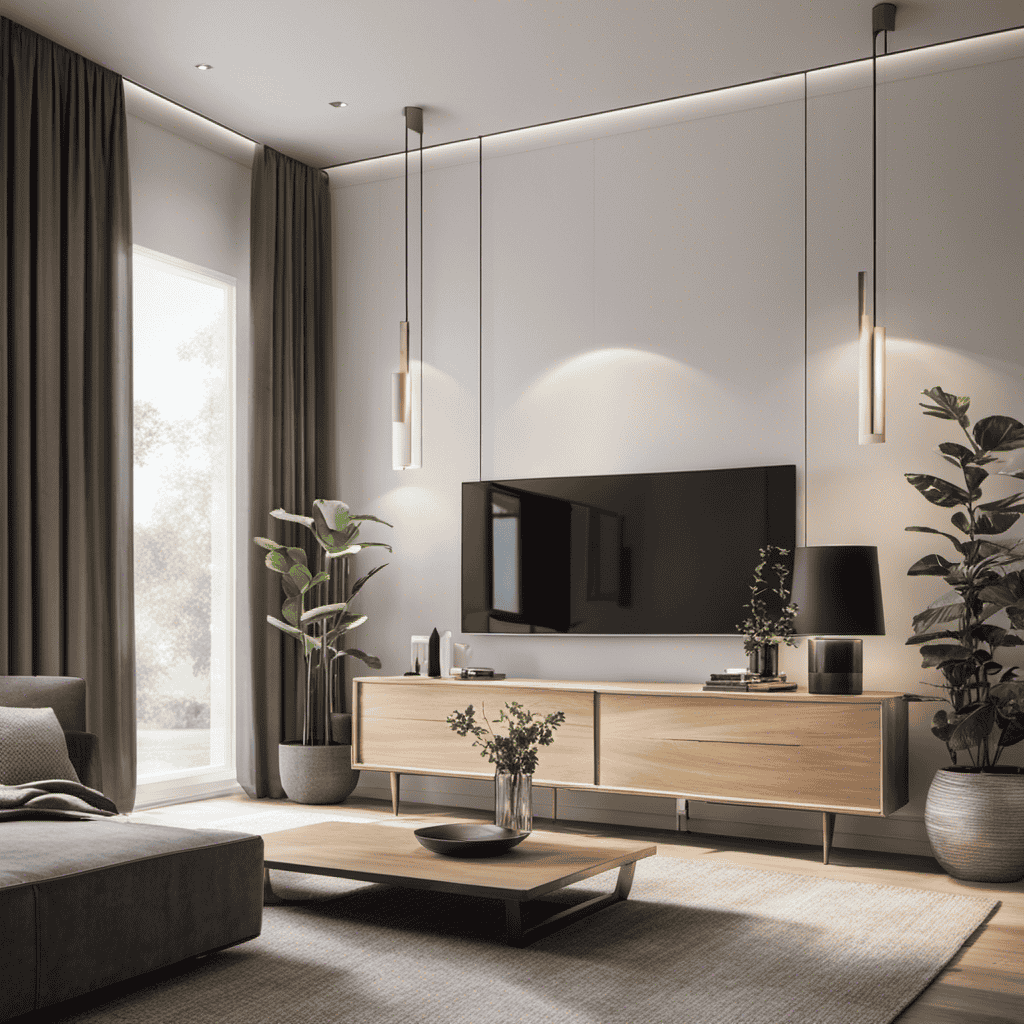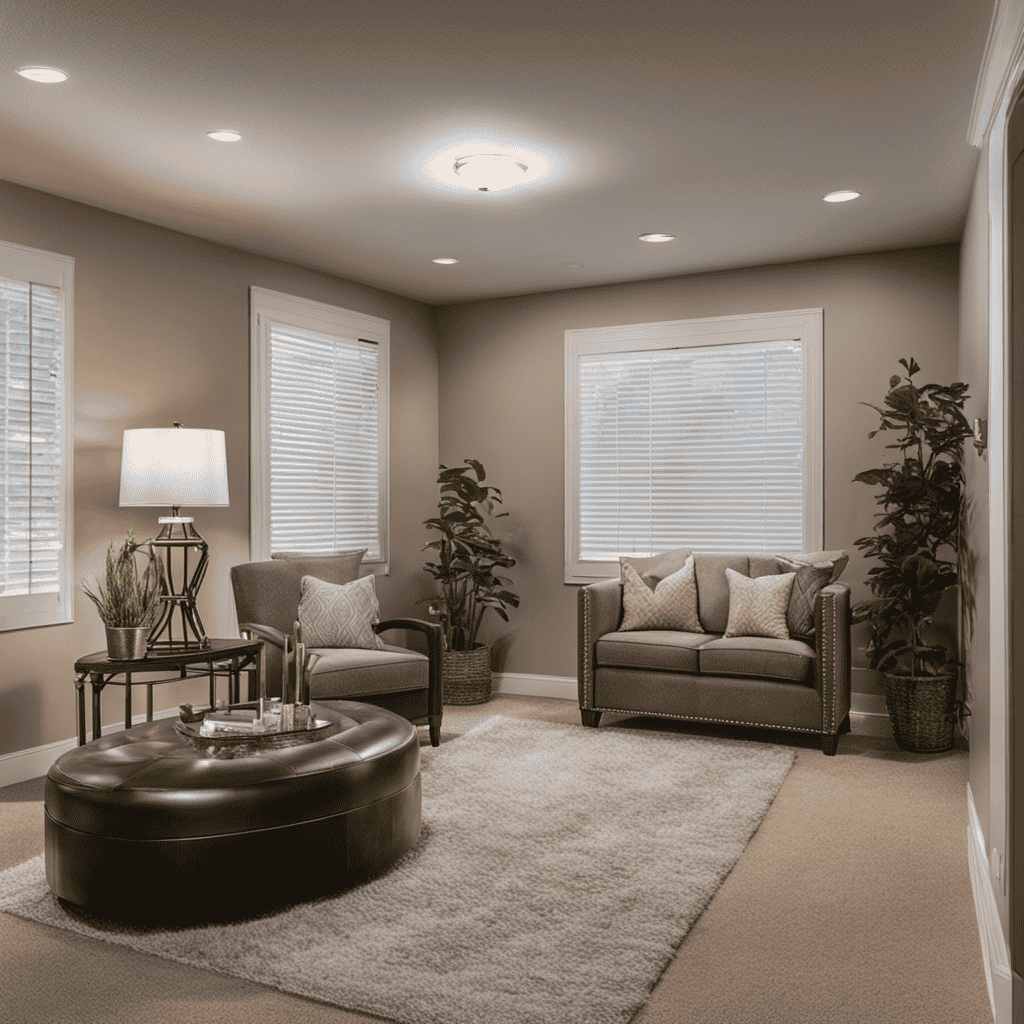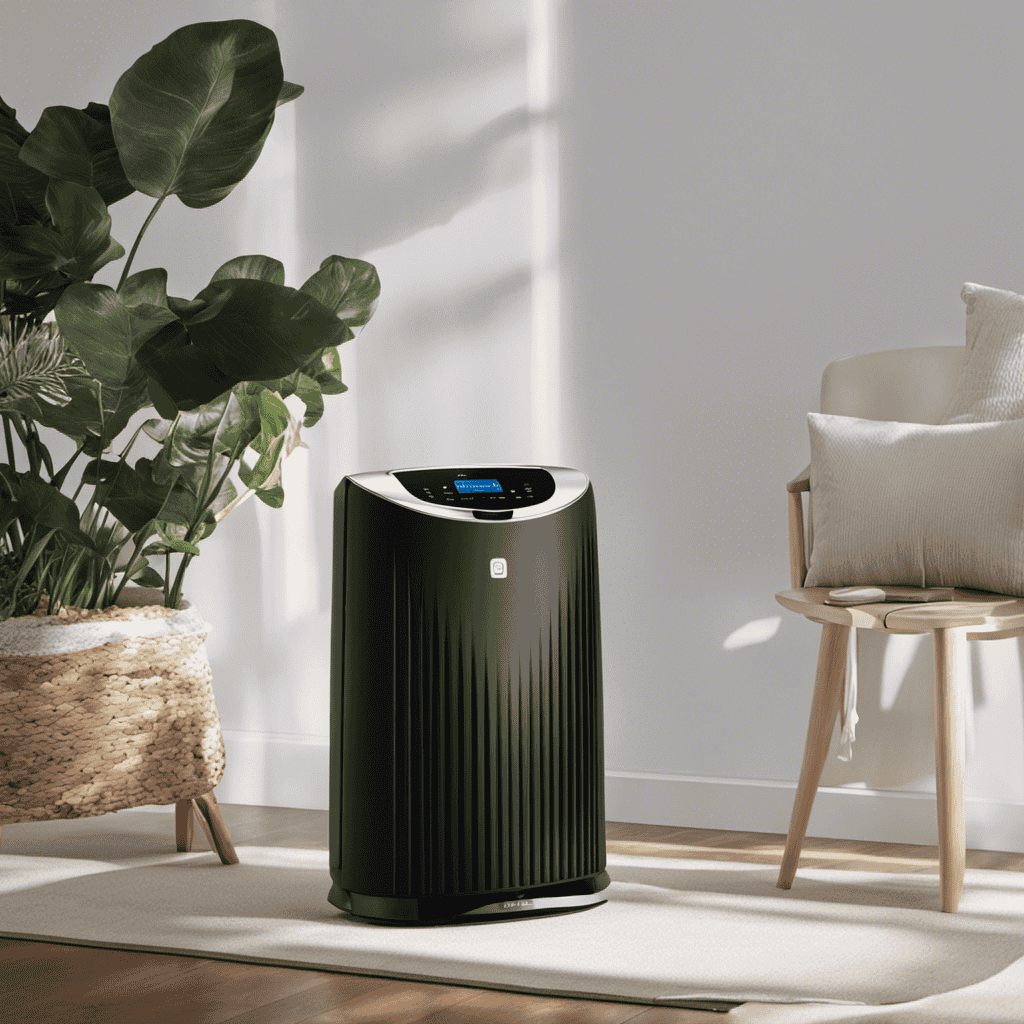I have always believed that nature has the power to heal and enhance our lives.
Did you know that certain plants can actually purify the air in our homes? It’s fascinating how these green wonders can remove harmful toxins and enhance indoor air quality.
In this article, we’ll explore the top air-purifying plants that not only beautify our living spaces but also have incredible health benefits.
So, if you’re curious about which plants can transform your home into a clean and fresh sanctuary, keep reading!
Key Takeaways
- Plants improve indoor air quality by removing harmful toxins.
- Being around plants can reduce stress, anxiety, and depression.
- Plants enhance cognitive function and improve concentration.
- Having plants in indoor spaces increases feelings of calmness and well-being.
Benefits of Using Plants as Air Purifiers
Plants are great at purifying the air, making them an excellent choice for improving indoor air quality.
But did you know that having plants in your environment can also have significant benefits for your mental health and productivity?
Numerous studies have shown that being around plants can reduce stress, anxiety, and even depression. The presence of plants in indoor spaces has been linked to increased feelings of calmness and well-being.
Additionally, plants have been found to enhance cognitive function and improve concentration and focus. This can have a direct impact on productivity levels, making plants a valuable addition to any workspace or study area.
Top 6 Air-Purifying Plants for Your Home
When it comes to creating a healthier indoor environment, incorporating air-purifying plants is a great place to start. Not only do these plants add a touch of beauty to your living space, but they also have numerous benefits.
From removing harmful toxins to increasing humidity levels, indoor plants can improve air quality and promote overall well-being.
In this discussion, I will explore the best air-purifying plants, the benefits they provide, and some care tips to help you maintain a thriving indoor garden.
Best Air-Purifying Plants
If you want cleaner air in your home, you should consider getting some of the best air-purifying plants. These plants not only add beauty to your space, but they also help remove harmful pollutants from the air.
When it comes to small spaces, there are a few air purifying plants that are perfect for purifying the air. One such plant is the Spider Plant, which is known for its ability to remove formaldehyde and xylene from the air.
Another great option is the Peace Lily, which is effective in removing common indoor pollutants.
When it comes to offices, some of the best air purifying plants include the Snake Plant and the English Ivy. These plants are low maintenance and can thrive in low-light conditions.
Benefits of Indoor Plants
To improve the overall well-being of your living space, consider incorporating indoor plants into your decor. Not only do plants add a touch of natural beauty, but they also provide numerous benefits for your health and well-being.
One of the main advantages of gardening indoors is the ability of plants to purify the air. Through a process called photosynthesis, plants absorb carbon dioxide and release oxygen, improving the air quality in your home. This can help reduce symptoms of allergies and asthma, as well as increase your overall energy levels.
Additionally, creating a plant-filled environment can have a calming effect on your mind and reduce stress levels. Studies have shown that being around plants can improve mood, increase productivity, and even enhance concentration.
Care Tips for Plants?
Water your indoor plants regularly to ensure they stay healthy and vibrant. Proper watering frequency and sunlight requirements are crucial for the well-being of your plants. It’s important to understand the specific needs of each plant in order to provide the right care. Here is a table outlining the watering frequency and sunlight requirements for common indoor plants:
| Plant | Watering Frequency | Sunlight Requirements |
|---|---|---|
| Spider Plant | Once a week | Indirect sunlight |
| Pothos | When the top inch dries | Low to medium sunlight |
| Snake Plant | Every 2-3 weeks | Low to bright sunlight |
Spider plants prefer to dry out between waterings, while pothos and snake plants can tolerate some drought. Regarding sunlight, spider plants thrive in indirect sunlight, while pothos and snake plants can adapt to a wider range of light conditions. Remember to adjust watering and sunlight based on the specific needs of your plants to ensure their health and longevity.
How Plants Improve Indoor Air Quality
Plants can effectively remove toxins and pollutants from the air indoors, making them excellent natural air purifiers. Indoor air quality is a crucial factor in maintaining good health, as poor air quality can lead to various respiratory issues and allergies.
By having plants indoors, we can significantly improve the air we breathe and reduce the presence of harmful substances. Through a process called phytoremediation, plants absorb pollutants through their leaves and roots, breaking them down into harmless byproducts. This natural purification process not only improves the air quality but also enhances our overall well-being.
Some plants, such as the Snake Plant and the Spider Plant, are particularly efficient at reducing toxins like formaldehyde and benzene. So, incorporating these air-purifying plants into our indoor spaces is a simple yet effective way to promote a healthier environment.
Factors to Consider When Choosing Air-Purifying Plants
When it comes to choosing the ideal indoor plant for air purification, there are several factors to consider.
First and foremost, it is important to select a plant that is known for its air-purifying properties, such as the snake plant or the peace lily.
Additionally, it is essential to understand the maintenance requirements of the chosen plant, including factors such as watering needs, light exposure, and temperature preferences.
Lastly, it is crucial to assess the air-purifying effectiveness of the plant, by considering factors such as its ability to remove toxins and improve air quality.
Ideal Indoor Plant
To find an ideal indoor plant for purifying the air, you should consider factors like lighting and maintenance. Here are three of the best air purifying plants that tick all the boxes:
-
Snake Plant (Sansevieria trifasciata): This plant is a superstar when it comes to air purification. It thrives in low light conditions and can tolerate neglect, making it perfect for beginners.
-
Peace Lily (Spathiphyllum): Not only does the Peace Lily remove harmful toxins from the air, but it also adds a touch of elegance to any space. It prefers bright, indirect light and regular watering.
-
Spider Plant (Chlorophytum comosum): This plant is known for its ability to remove formaldehyde from the air. It enjoys bright, indirect light and moderate watering.
These plants are not only effective at purifying the air, but they are also low-maintenance, making them ideal choices for any indoor space.
Now, let’s dive into their maintenance requirements.
Maintenance Requirements
If you want your indoor greenery to thrive, make sure you water and fertilize them regularly.
Maintaining indoor plants requires a few essential maintenance tips to ensure their health and longevity.
Firstly, it’s crucial to water your plants consistently, allowing the soil to dry out slightly between waterings. Overwatering can lead to root rot and other common plant diseases.
Secondly, fertilize your plants with a balanced houseplant fertilizer every two to four weeks during the growing season. This will provide them with the necessary nutrients for healthy growth.
Additionally, it’s important to inspect your plants regularly for any signs of common plant diseases, such as powdery mildew or spider mites. If you notice any issues, take immediate action to treat and prevent further damage.
Air-Purifying Effectiveness?
You can enhance the air quality in your space by choosing certain indoor plants that are known for their ability to filter and purify the surrounding environment.
When it comes to air-purifying effectiveness, it’s important to understand the difference between effectiveness and efficiency. While effectiveness refers to the ability of a plant to remove pollutants from the air, efficiency measures how well the plant uses resources like water and light to carry out this process.
The impact on health is another crucial aspect to consider. Indoor plants have been shown to reduce stress, improve mood, and even enhance cognitive function.
Tips for Caring and Maintaining Air-Purifying Plants
Caring for and maintaining air-purifying plants is essential for their optimal performance. As a plant lover and enthusiast, I have learned some valuable caring techniques and have also made a few common mistakes along the way. To help you avoid these mistakes and ensure the longevity of your air-purifying plants, I have compiled a list of tips:
-
Light: Provide your plants with the right amount of light. Too much or too little can hinder their growth and purification abilities.
-
Watering: Be mindful of your watering schedule. Overwatering can lead to root rot, while underwatering can cause the plants to wilt and weaken.
-
Soil: Use well-draining soil to prevent waterlogging and promote healthy root development.
-
Pruning: Regularly prune your plants to remove dead leaves and encourage new growth.
Remember, each plant has its own specific care requirements, so it’s important to research and understand the needs of your particular air-purifying plants.
| Mistake | Consequence | Solution |
|---|---|---|
| Overwatering | Root rot | Adjust watering schedule and use well-draining soil |
| Insufficient light | Weak growth | Provide adequate light or move plant to a brighter location |
| Neglecting pruning | Accumulation of dead leaves | Regularly remove dead leaves to promote new growth |
| Using incorrect soil | Waterlogging | Use well-draining soil suitable for air-purifying plants |
Incorporating Air-Purifying Plants Into Your Home Decor
When selecting air-purifying plants for your home decor, consider their aesthetic appeal and how they can complement your existing design. Incorporating air-purifying plants into your home decor not only adds a touch of nature, but also provides numerous benefits for your indoor environment.
Here are three reasons why using plants as home decor is a great idea:
-
Improved air quality: Air-purifying plants have the ability to filter toxins from the air, improving the overall air quality in your home. They can remove common indoor pollutants such as formaldehyde, benzene, and trichloroethylene.
-
Increased humidity: Many indoor plants release moisture through a process called transpiration, which helps to increase humidity levels. This can be especially beneficial during dry winter months or in areas with low humidity.
-
Stress reduction: Studies have shown that being surrounded by plants can help to reduce stress and improve overall well-being. They can create a calming and soothing environment, promoting relaxation and a sense of tranquility.
Frequently Asked Questions
How Do Air-Purifying Plants Actually Clean the Air in Our Homes?
Air-purifying plants clean the air by absorbing harmful toxins through their leaves and roots. They release oxygen and moisture, which improves indoor air quality. Research shows the benefits of having these plants in your home.
Can Air-Purifying Plants Remove Harmful Chemicals and Toxins From the Air?
Do air-purifying plants really remove harmful chemicals and toxins from the air? Well, let me tell you, air purifying plants can indeed improve indoor air quality by absorbing pollutants and releasing oxygen. It’s science!
Are There Any Specific Plants That Are More Effective at Purifying the Air Than Others?
There are specific plants that are more effective at purifying the air than others. These air purifying plants have numerous benefits for indoor air quality, such as removing harmful chemicals and toxins.
Do Air-Purifying Plants Require Any Special Care or Maintenance?
Special care and maintenance requirements for air purifying plants depend on the specific species. However, most air purifying plants benefit from regular watering, proper sunlight exposure, and occasional pruning to ensure optimal air purification in indoor spaces.
Can Air-Purifying Plants Help Reduce Symptoms of Allergies or Asthma?
Yes, air-purifying plants can help reduce symptoms of allergies or asthma. They improve indoor air quality by removing toxins and releasing oxygen. Having air purifying plants at home has many benefits for our health.
Conclusion
In conclusion, incorporating air-purifying plants into your home decor is a wise decision for improving indoor air quality. These green wonders not only add beauty and freshness to your space but also filter out harmful toxins and pollutants.
From the peace lily to the spider plant, there are various plant options available that can effectively cleanse the air. So why not bring a touch of nature inside and let these natural air purifiers do their magic?
Your lungs will thank you for it!










